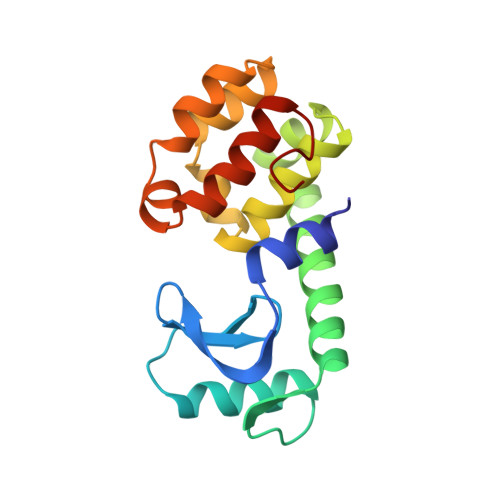Comparison of the crystal structure of bacteriophage T4 lysozyme at low, medium, and high ionic strengths.
Bell, J.A., Wilson, K.P., Zhang, X.J., Faber, H.R., Nicholson, H., Matthews, B.W.(1991) Proteins 10: 10-21
- PubMed: 2062826
- DOI: https://doi.org/10.1002/prot.340100103
- Primary Citation of Related Structures:
4LZM, 5LZM, 6LZM, 7LZM - PubMed Abstract:
Crystals of bacteriophage T4 lysozyme used for structural studies are routinely grown from concentrated phosphate solutions. It has been found that crystals in the same space group can also be grown from solutions containing 0.05 M imidazole chloride, 0.4 M sodium choride, and 30% polyethylene glycol 3500. These crystals, in addition, can also be equilibrated with a similar mother liquor in which the sodium chloride concentration is reduced to 0.025 M. The availability of these three crystal variants has permitted the structure of T4 lysozyme to be compared at low, medium, and high ionic strength. At the same time the X-ray structure of phage T4 lysozyme crystallized from phosphate solutions has been further refined against a new and improved X-ray diffraction data set. The structures of T4 lysozyme in the crystals grown with polyethylene glycol as a precipitant, regardless of the sodium chloride concentration, were very similar to the structure in crystals grown from concentrated phosphate solutions. The main differences are related to the formation of mixed disulfides between cysteine residues 54 and 97 and 2-mercaptoethanol, rather than to the differences in the salt concentration in the crystal mother liquor. Formation of the mixed disulfide at residue 54 resulted in the displacement of Arg-52 and the disruption of the salt bridge between this residue and Glu-62. Other than this change, no obvious alterations in existing salt bridges in T4 lysozyme were observed. Neither did the reduction in the ionic strength of the mother liquor result in the formation of new salt bridge interactions. These results are consistent with the ideas that a crystal structure determined at high salt concentrations is a good representation of the structure at lower ionic strengths, and that models of electrostatic interactions in proteins that are based on crystal structures determined at high salt concentrations are likely to be relevant at physiological ionic strengths.
Organizational Affiliation:
Department of Physics, University of Oregon, Eugene 97403.
















